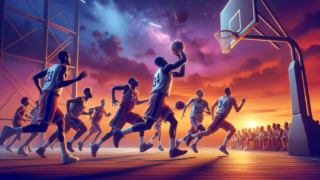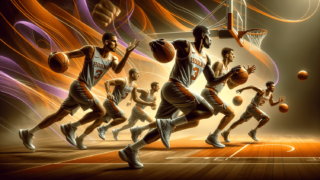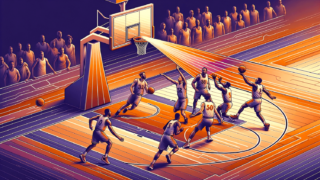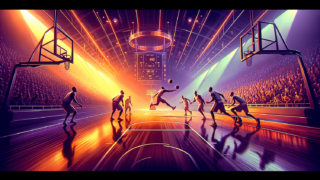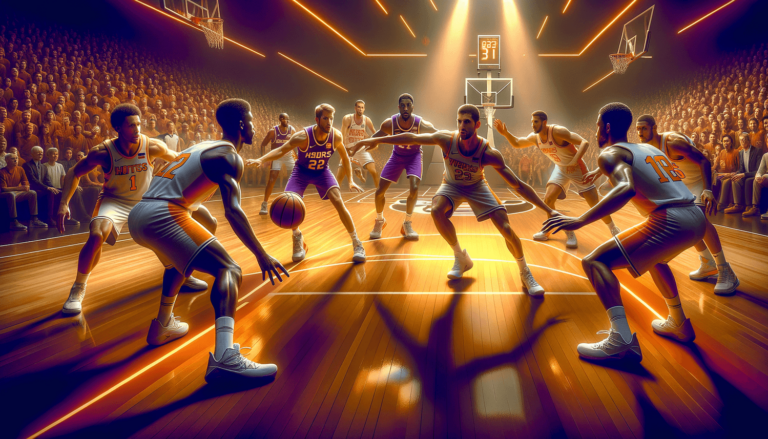
Welcome to the wonderful world of basketball tactics! 🌐 In today’s blog post, we dive into the intricacies of the Horns 2 Side Offense – an offensive strategy that is as fascinating as it is effective. Are you eager to expand your basketball knowledge and discover how this clever configuration translates to success on the court? Then, lace up your sneakers and join us as we break down the mechanics of the Horns 2 Side Offense, highlighting its versatile components, key players’ roles, and the thrilling on-court action it promises. It’s time to delve into the strategic side of our beloved game, and don’t worry, we’ve got your back! 🏀
What’s a Horns 2 Side Offense in Basketball?
The Horns 2 Side Offense in basketball is a versatile offensive strategy that positions two players (typically the power forward and center) at both elbows of the free throw line and two players (usually the shooting guard and small forward) in the corners. The point guard initiates the offense by dribbling the ball towards either side of the court, triggering various plays such as pick-and-rolls, screens, and off-the-ball movements to exploit defensive mismatches and create scoring opportunities.
The Origins of the Horns 2 Side Offense
The Horns 2 Side Offense has its roots in European basketball, earning widespread acclaim for its ability to facilitate organic ball movement and unpredictability. Adopted by numerous international and NBA coaches, this offensive system has proven its potential to level the playing field, increasing competitiveness by maximizing a team’s multifaceted strengths.
Breaking Down the Component Positions
To develop an in-depth understanding of the Horns 2 Side Offense, it’s vital to examine the roles and responsibilities of each player on the court. By grasping the essence of these positions, basketball enthusiasts can appreciate the dynamic interplay among the team, as well as the tactical fierceness of this offensive strategy.
The Point Guard (PG)
The Point Guard, often referred to as the floor general or conductor, is the one responsible for initiating the offensive sequence. Typically exhibiting exceptional dribbling and passing skills, the PG’s primary objective is to facilitate offensive synchronization, ultimately providing the most favorable scoring opportunities. In the Horns 2 Side Offense, a good decision-maker is invaluable, as the PG governs the pace of play and selects the optimal route based on teammates’ strengths and defensive adjustments.
The Shooting Guard (SG) and Small Forward (SF)
Both the Shooting Guard and Small Forward are positioned in the corners during the Horns 2 Side Offense, ready to act as prominent floor spacers. Possessing a reliable outside shot is crucial to keeping the opposing team’s defenders honest and engaged. If the defense collapses on the ball handler, the two wings play a critical role in relocating and sliding along the three-point line to provide catch-and-shoot opportunities. Additionally, they may slash towards the basket, exploit defensive breakdowns, and participate in off-the-ball screening action to create further scoring chances.
The Power Forward (PF) and Center (C)
The twin towers of the Horns 2 Side Offense, the Power Forward and Center, set their positions at the elbows of the free-throw line. This strategic placement is critical, as it presents a series of wrinkles against opposing defenses. In these roles, the PF and C frequently engage in pick-and-roll or pick-and-pop plays, enabling the ball handler to penetrate the paint or launch a shot from beyond the arc. Additionally, their positioning facilitates post-up sequences, high-to-low passing, and hand-offs, bolstering the overall effectiveness of the Horns 2 Side Offense.
Mastering the Art of the Pick-and-Roll
Central to the success of the Horns 2 Side Offense is the infamous pick-and-roll. This fundamental play surfaces whenever the ball handler’s defender is confronted with a screen, forcing a defensive rotation or creating an open lane to exploit. It’s vital for the offensive players to excel at setting solid screens and rolling to the basket with both speed and purpose. Hand-eye coordination, effective communication, and precise execution are necessary to capitalize on the potential vulnerabilities exposed within the opposing defense.
Feeding the Post
In the Horns 2 Side Offense, the ability to feed the post serves as another powerful weapon. Two things can happen here: either the offensive player fakes the pass, driving to the hoop, or they dish the ball off to a teammate in the low post. Patience is paramount in this scenario, as is the adeptness to read the defense and anticipate the floor’s evolution.
Flair for Flares: Pin-Down Screens and Flare Screens
Creating opportunities through screening action is integral to the Horns 2 Side Offense. Pin-down and flare screens, in particular, serve as crucial building blocks in constructing an adaptable and resilient offensive scheme.
Pin-Down Screens
Pin-down screens are designed to free up shooters situated on the wing to receive the ball from the point guard or the post position. This action happens when an offensive player, typically the big man, sets a screen for the wing player, who curls towards the top of the key to receive the pass. Timing is critical in this scheme, as a perfectly executed pin-down screen grants the shooter ample space to deliver a high-percentage shot.
Flare Screens
Flare screens occur when an offensive player sets a screen away from the ball handler, encouraging their teammate to move in the opposite direction. Capitalizing on clever misdirection, this action is effective at exploiting the defensive rotation, often resulting in a wide-open shot. The success of the flare screen hinges on unyielding communication and well-timed execution, fostering an environment in which the offense operates with clockwork precision.
Driving and Dishing: Maximizing Penetration
Beyond the world of screens and picks, penetration lies at the heart of the Horns 2 Side Offense. Driving hard towards the basket, maneuvering past defenders, and creating shot opportunities for teammates are crucial elements of this system, maximized in the hands of an aggressive point guard.
Kicking Out to the Wings
At its core, “kicking out” refers to a point guard driving into the paint and dishing the ball out to a teammate positioned on the three-point line. The Horns 2 Side Offense naturally promotes spacing, empowering team members to maximize these opportunities when the defense collapses on the ball handler. Mastery of this tactic requires a harmonious blend of penetration, a keen sense of court awareness, and deft passing skills.
Finding the Cutting Teammate
Dicing through the defense is another essential tenet of the Horns 2 Side Offense. A cutting teammate can attack the basket with a sharp, decisive move when their defender turns their back or takes their eyes off the ball. Capitalizing on these fleeting opportunities demands seamless integration between the ball handler and off-the-ball movement, as well as an unwavering focus on maintaining proper spacing throughout.
Weaving Magic: Handoff Plays
The Horns 2 Side Offense also showcases a variety of handoff plays, affording a perfect blend of unpredictability, spacing, and offensive fluidity. While not as flashy as thundering dunks or laser-precise passes, the humble handoff contributes to the offense’s smooth functioning, interweaving simplicity and deception.
The Dribble Handoff
When the point guard drives towards a teammate on the wing in the Horns 2 Side Offense, they may engage in a dribble handoff. The purpose here is to momentarily freeze the defender, facilitating a quick-change of direction, and empowering the recipient of the handoff to either shoot, drive, or execute a pick-and-roll.
The Post-to-Wing Handoff
Another variation of the handoff scheme in the Horns 2 Side Offense occurs when the post player at the elbow passes the ball to a cutting wing player. This action seizes on the defense’s shifting focus, and the wing player has options to shoot, drive, or kick the ball back out. Mastery of this maneuver hinges on the court vision of both the post player and the wing, as well as their ability to read the defense and capitalize on the ensuing chaos.
The Unseen Glue: Communication and Court Awareness
Though often overlooked, communication and court awareness form the lifeblood of the Horns 2 Side Offense. To fully grasp its enchanted subtleties, one must focus on these crucial, behind-the-scenes aspects that render this offense a formidable and timeless force within the basketball landscape.
Communicating On-Court
Proactive communication among players ensures a free-flowing, cohesive offense capable of responding to even the most aggressive defensive adjustments. From screens to cuts, handoffs, and pick-and-roll action, each component within the Horns 2 Side Offense demands teamwork and focus, ensuring that all team members operate in harmony and deliver peak performance.
Enhancing Court Awareness
A heightened sense of court awareness translates to a formidable offensive prowess, empowered by lightning-fast response times and unwavering concentration. In the context of the Horns 2 Side Offense, court awareness allows players to read defensive schemes, anticipate movements, and adapt to ever-changing floor conditions, ensuring fluidity and resilience – hallmarks of a transcendent basketball strategy.
Notable Examples and Success Stories
Throughout the course of basketball history, the Horns 2 Side Offense has been employed and mastered by numerous successful teams and coaches. By examining these notable examples, we not only appreciate the effectiveness of this offensive system but also gain inspiration for implementing and tweaking it within our basketball pursuits.
The San Antonio Spurs: A Model of Excellence
Under the tutelage of legendary coach Gregg Popovich, the San Antonio Spurs consistently emerged as an offensive powerhouse, often incorporating the Horns 2 Side Offense to devastating effect. With a stellar roster of players like Tim Duncan, Tony Parker, and Manu Ginóbili, the Spurs were able to execute the Horns 2 Side Offense with incredible finesse, providing a blueprint that many coaches at various levels have since sought to emulate.
European Influence: FIBA Basketball
As mentioned earlier, the inception of the Horns 2 Side Offense has its roots in European basketball. Consequently, numerous FIBA competitions have seen the use of the Horns 2 Side Offense by teams seeking to optimize offensive fluidity and versatility. These international successes have substantiated the efficacy of this offensive system, prompting its widespread adoption on a global scale.
Coaching Tips and Best Practices
Understanding the Horns 2 Side Offense is one thing; effectively coaching and implementing it is an entirely different challenge. With an eye towards inspiring coaches and players alike, this section sheds light on valuable tips and best practices, aimed at optimizing success within the context of this complex offensive system.
Emphasizing Fundamentals
For coaches seeking to teach the Horns 2 Side Offense, it’s vital to emphasize the importance of fundamentals. From setting solid screens to mastering the art of the pick-and-roll and honing passing skills, fostering a strong foundation in the core basics is essential to achieving success within this offensive scheme.
Instilling Unselfish Play
The Horns 2 Side Offense thrives on teamwork and collaboration, rendering unselfish play critical to the system’s success. Encourage players to make the extra pass, share the ball, and prioritize scoring opportunities for their teammates. This mindset engenders a sense of collective strength and unity, lending the team greater resilience when faced with defensive pressure or adversity.
Adapting to Your Team’s Strengths
While the basic structure of the Horns 2 Side Offense provides a flexible and versatile framework, it’s important for coaches to adapt the system to their team’s specific strengths. This might involve an emphasis on stretching the floor with reliable outside shooters or exploiting the skills of dominant post players. By tailoring the offense to suit your roster, you showcase your team’s strengths and maximize your chances of success.
FAQ: Horns 2 Side Offense – Your Questions Answered
Still got some burning questions about the Horns 2 Side Offense? Don’t worry, we’ve got you covered. This frequently asked questions (FAQ) section delves into 13 common questions, providing concise and informative NLP-style answers to further enhance your understanding of this powerful offensive system.
1. Can the Horns 2 Side Offense work with a smaller lineup?
Yes, the Horns 2 Side Offense can be adapted to work with a smaller lineup. By employing versatile forwards and centers with strong outside shooting abilities and aptitude for spreading the floor, a smaller lineup can maximize the system’s space-creating potential and exploit mismatches.
2. Is the Horns 2 Side Offense suitable for youth basketball teams?
Absolutely! The Horns 2 Side Offense is a great system for youth basketball teams, as it emphasizes fundamental skills and teamwork. It offers valuable opportunities for young players to develop on-court communication, solidify their fundamentals, and foster a collaborative mindset.
3. How does transition offense fit into the Horns 2 Side Offense?
Transition offense can be seamlessly integrated into the Horns 2 Side Offense. Whenever a fast-break opportunity arises, the team should exploit it. However, if the defense successfully slows down the transition, players can then flow into the Horns 2 Side configuration and initiate the half-court offense.
4. How do players handle switches and mismatches in the Horns 2 Side Offense?
When defensive switches or mismatches occur, the Horns 2 Side Offense encourages players to capitalize on these advantageous situations. They can exploit mismatches using post-ups, isolation plays, or high-to-low passes that maximize opportunities for easy buckets and collapses in the defense.
5. Can the Horns 2 Side Offense be used alongside other offensive systems?
Yes, the Horns 2 Side Offense can coexist with other offensive systems, providing teams with a wealth of strategic options. By incorporating elements from multiple offensive schemes, coaches can craft a dynamic offensive approach that keeps opponents guessing and maximizes their teams’ strengths.
6. What are the main benefits of the Horns 2 Side Offense?
The Horns 2 Side Offense offers numerous benefits, such as its emphasis on teamwork, communication, and fundamental skills. Its adaptability allows for exploitation of mismatches, the creation of open shots, and a balanced offensive approach that promotes both inside and outside scoring.
7. How can coaches counter the Horns 2 Side Offense?
To counter the Horns 2 Side Offense, coaches must emphasize strong defensive communication, quick rotations, and disciplined closeouts on shooters. Effective strategies may include switching or hedging on screens, forcing players into contested shots, or emphasizing aggressive help defense.
8. Is the Horns 2 Side Offense effective against zone defense?
While the Horns 2 Side Offense is primarily designed for facing man-to-man defenses, it can be adapted to exploit gaps and vulnerabilities in a zone defense. Key strategies include utilizing timely ball reversals, interspersing dribble penetration, and focusing on crisp, accurate passes.
9. How does the Horns 2 Side Offense impact pace of play?
The Horns 2 Side Offense allows a team to control the pace of play, as it enables players to methodically break down the defense and focus on efficient shot selection. However, the system remains flexible enough to accommodate fast-break opportunities and sudden tempo shifts when advantageous.
10. Can the Horns 2 Side Offense be effective without a dominant post presence?
Yes, the Horns 2 Side Offense can still be effective without a dominant post player. A team can emphasize outside shooting, drive-and-kick plays, and pick-and-roll sequences to compensate for the lack of a traditional post presence, thereby capitalizing on floor spacing and creating open shots for perimeter players.
11. How much practice time should be devoted to learning the Horns 2 Side Offense?
The amount of practice time required for mastering the Horns 2 Side Offense varies depending on the skill level and experience of the team. Coaches should regularly allocate time to reinforcing fundamental skills, developing teamwork and communication, and practicing offensive sequences within the context of this system.
12. Are there any major weaknesses or drawbacks to the Horns 2 Side Offense?
As with any offensive system, the Horns 2 Side Offense is not without potential weaknesses. Defensive schemes specifically designed to counter this offense can be problematic, as can a lack of strong outside shooting or versatile post play. However, regular practice and strategic adjustments can help alleviate these challenges.
13. What character traits should players possess to excel in the Horns 2 Side Offense?
Players seeking to excel in the Horns 2 Side Offense should possess a strong work ethic, a high basketball IQ, effective communication skills, and adaptability. Additionally, fundamental skills such as passing, shooting, setting screens, and reading the defense are essential to maximizing success within this offensive system.
Featured Posts
- No pillar pages found.

